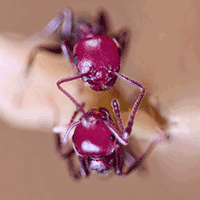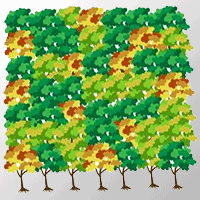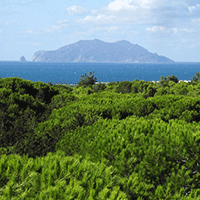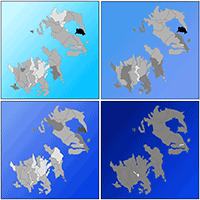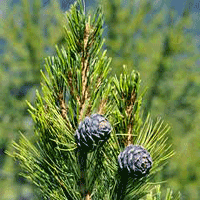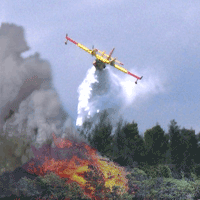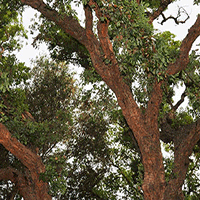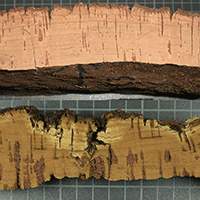
Influence of site conditions and land management on Quercus suber L. population dynamics in the southern Iberian Peninsula
Vicente Jurado Doña (1), Javier López-Jurado (2) , Antonio González Román (3-4), Raúl Sánchez-Salguero (4), Luis Matías (2), Fernando Díaz Del Olmo (1)
iForest - Biogeosciences and Forestry, Volume 15, Issue 2, Pages 77-84 (2022)
doi: https://doi.org/10.3832/ifor3753-015
Published: Mar 14, 2022 - Copyright © 2022 SISEF
Research Articles
Abstract
During recent decades, tree mortality and dieback have been reported in forest ecosystems across global biomes. Although numerous forest species, including those of the genus Quercus, have been affected by hotter and drier conditions in the Mediterranean Basin during the last decades, there is scarce information regarding the interactive role of past management and climate across large areas of south-western Europe. Here, we examined the influence of several climatic factors (mean annual temperature, annual precipitation) over the last 3 decades, latitude, land management and site conditions on the cork oak (Quercus suber L.) population dynamics given their high ecological and economic relevance. We sampled 20 plots across contrasting environmental conditions in SW Iberian Peninsula with different land property (public vs. private) to characterize cork oak tree size, stand density, mortality ratio and regeneration. We observed widespread effects of latitude (8.9% at northern vs. 15.6% at southern plots) and land property (6.9% in private properties vs. 13.9% in public ones) on tree mortality. Tree density and basal area differed with latitude, with higher values (307.2 trees ha-1 and 38.4 m2 ha-1, respectively) at northern populations. In addition, the more intense cork-focused productive management resulted in higher tree sizes in private (mean DBH = 47.3 cm) than in public (mean DBH = 37.8 cm) plots. Tree regeneration was higher in northern forests (94.9 ± 25.2 vs. 26.0 ± 6.1 saplings ha-1 for the southern location), being this difference more pronounced in public plots. These findings highlight the importance of sustainable forest management in public and private forests for further reduction of mortality processes, as well as for enhancing the regeneration aimed to the conservation of cork oak under forecasted drier conditions of these economically invaluable Mediterranean forests.
Keywords
Cork Oak, Climate Change, Forest Management, Mediterranean, Land Uses, Tree Mortality
Authors’ Info
Authors’ address
Fernando Díaz Del Olmo 0000-0002-0658-4989
Departamento de Geografía Física y Análisis Geográfico Regional, Universidad de Sevilla, E-41004 Sevilla (Spain)
Luis Matías 0000-0001-5603-5390
Departamento de Biología Vegetal y Ecología, Universidad de Sevilla, Apdo. 1095, E-41080 Sevilla (Spain)
Fundación Jaime González Gordon, E-11407 Jerez de la Frontera - Cádiz (Spain)
Raúl Sánchez-Salguero 0000-0002-6545-5810
Departamento de Sistemas Físicos, Químicos y Naturales, Universidad Pablo de Olavide, E-41013 Sevilla (Spain)
Corresponding author
Paper Info
Citation
Jurado Doña V, López-Jurado J, González Román A, Sánchez-Salguero R, Matías L, Díaz Del Olmo F (2022). Influence of site conditions and land management on Quercus suber L. population dynamics in the southern Iberian Peninsula. iForest 15: 77-84. - doi: 10.3832/ifor3753-015
Academic Editor
Tamir Klein
Paper history
Received: Jan 13, 2021
Accepted: Jan 10, 2022
First online: Mar 14, 2022
Publication Date: Apr 30, 2022
Publication Time: 2.10 months
Copyright Information
© SISEF - The Italian Society of Silviculture and Forest Ecology 2022
Open Access
This article is distributed under the terms of the Creative Commons Attribution-Non Commercial 4.0 International (https://creativecommons.org/licenses/by-nc/4.0/), which permits unrestricted use, distribution, and reproduction in any medium, provided you give appropriate credit to the original author(s) and the source, provide a link to the Creative Commons license, and indicate if changes were made.
Web Metrics
Breakdown by View Type
Article Usage
Total Article Views: 31571
(from publication date up to now)
Breakdown by View Type
HTML Page Views: 26626
Abstract Page Views: 2691
PDF Downloads: 1744
Citation/Reference Downloads: 2
XML Downloads: 508
Web Metrics
Days since publication: 1372
Overall contacts: 31571
Avg. contacts per week: 161.08
Citation Metrics
Article Citations
Article citations are based on data periodically collected from the Clarivate Web of Science web site
(last update: Mar 2025)
Total number of cites (since 2022): 2
Average cites per year: 0.50
Publication Metrics
by Dimensions ©
Articles citing this article
List of the papers citing this article based on CrossRef Cited-by.
References
A global overview of drought and heat-induced tree mortality reveals emerging climate change risks for forests. Forest Ecology and Management 259: 660-684.
CrossRef | Gscholar
Abrupt increases in Amazonian tree mortality due to drought-fire interactions. Proceedings of the National Academy of Sciences USA 111: 6347-6352.
CrossRef | Gscholar
Industria forestal-agrícola [Forest-agricultural industry]. Establecimiento Tipográfico de la Biblioteca Nacional Económica de D. Francisco de P. Jordan, Cádiz, Spain, pp. 423. [in Spanish]
Gscholar
Manual de ordenación de montes de Andalucía [Andalusian forest management manual]. Consejería de Medio Ambiente, Junta de Andalucía, Seville, Spain, pp. 357. [in Spanish]
Gscholar
Mediterranean-type shrublands of the world. In: “Ecosystems of the World 11: Mediterranean-Type Shrublands” (Di Castri F, Goodall DW, Specht RL eds). Elsevier, Amsterdam, The Netherlands, pp. 1-52.
Gscholar
Exploring interactive effects of climate change and exotic pathogens on Quercus suber performance: damage caused by Phytophthora cinnamomi varies across contrasting scenarios of soil moisture. Agricultural and Forest Meteorology 276-277: 107605.
CrossRef | Gscholar
Los Larios y la industria corchera. Un caso de industrialización fallida en el Campo de Gibraltar. Revista de Historia Industrial [The Larios and the cork industry. A case study of failed industrialization in Campo de Gibraltar]. Revista de Historia Industrial 27: 49-90. [in Spanish]
Online | Gscholar
Los bosques de las Sierras del Aljibe y del Campo de Gibraltar (Cádiz-Málaga). Ecología, transformaciones históricas y gestión forestal [The forest of Aljibe and Campo de Gibraltar mountain ranges (Cadiz-Malaga). Ecology, historical transformations and forest management]. Consejería de Medio Ambiente, Junta de Andalucía, Seville, Spain, pp. 222. [in Spanish]
Gscholar
Regeneration of tree species and restoration under constrasted Mediterranean habitats: field and glasshouse experiments. International Journal of Ecology and Environmental Sciences 30: 187-196.
Online | Gscholar
Oak trees and woodlands providing ecosystem services in Southern Spain. In: Proceedings of the Conference “Trees Beyond the Wood” (Rotherham ID, Handley C, Agnoletti M, Samojlik T eds). Wildtrack Publishing, Sheffield, UK, pp. 369-378.
Online | Gscholar
Impactos de la herbivoría por ungulados en las comunidades de plantas leñosas del Parque Natural Los Alcornocales [Herbivory impacts by ungulates on woody plant communities of Los Alcornocales Natural Park]. Almoraima 49: 251-263. [in Spanish]
CrossRef | Gscholar
Forecasting tree growth in coppiced and high forests in the Czech Republic. The legacy of management drives the coming Quercus petraea climate responses. Forest Ecology and Management 405: 56-68.
CrossRef | Gscholar
Manufacture and trade of cork products: an international perspective. In: “Cork Oak Woodlands on the Edge. Ecology, Adaptative Management and Restoration” (Aronson J, Pereira JS, Pausas JG eds). Island Press, Washington, DC, USA, pp. 189-200.
Gscholar

